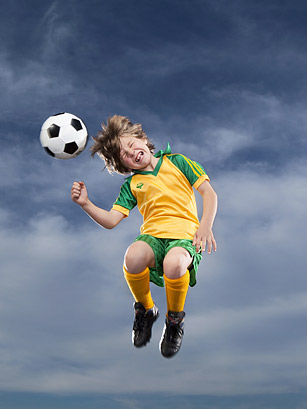
(4 of 4)
Maryland's Fairfax County has instituted a program in which student athletes spit into cups so their genetic profiles can be taken. The genomes of the ones who come down with concussions can then be compared for key similarities. Early attention is focusing on a gene that codes for a protein called ApoE, which has been implicated in Alzheimer's disease. In the long run, teasing out concussion genes could lead to better drugs or gene therapy to treat or prevent the injury. In the short run, it could help parents and coaches determine in advance which sports kids are best suited to play. Says Gioia: "We may actually find out, 'You know what? You're not set up to be a football player. You might be a better tennis player.'"
Newer brain-scanning technology is also making a difference, helping doctors diagnose concussions and track recovery. The microscopic size of tau proteins and nerve fibers makes them impossible to see without a postmortem exam, but three noninvasive techniques can help sidestep that problem. Magnetic resonance spectroscopy measures not direct damage to the brain but its metabolic activity — a good way to evaluate the very system that breaks down first when a brain is concussed. Diffusion tensor imaging can observe transmission along nerve-fiber tracks, providing a sense of the integrity of the neural wiring. And resting fMRI allows physicians to watch the brain when it's not performing a task, providing a look at basic function.
Changing the Rules
Smart medicine, of course, can do only so much to reverse the number of concussions. Smart policy must do the rest. To keep kids from hurting themselves — and to prevent coaches from enabling them — 10 states, including New Jersey, Oregon, Virginia and football-mad Oklahoma, have passed return-to-play laws requiring kids who have sustained even a suspected concussion in any sport to be pulled from play and not returned until a doctor or certified athletic trainer declares them fit. A handful of other states are considering similar legislation, and last year two separate bills along the same lines were introduced in the House of Representatives. Both will have to be resubmitted under the new GOP majority. Still, the national trend is clear: "When in doubt, sit them out" is how the advocates put it.
Most major professional sports leagues in the U.S., as well as most large universities and 4,000 high schools, now also use a computer program known as ImPACT (for Immediate Post-Concussion Assessment and Cognitive Testing) that measures such basic skills as memory, word recognition and pattern recognition. Players are required to take a baseline test at the beginning of the season and are periodically retested, especially postconcussion, to determine if there's been any erosion of skills. "I used to sit across from athletes doing paper-and-pencil memory tests," says ImPACT developer Mark Lovell, a neuropsychologist at the University of Pittsburgh Medical Center. "That would never work with large groups of kids. There aren't that many neuropsychologists alive."
Reform is also coming — slowly — to the major manufacturers of football helmets, driven mostly by the NFL, which has imposed much stricter concussion and tackling rules in the past season. The NFL is anxious both to protect its players and to shake its image as a weekly tutorial for student athletes learning all the wrong safety lessons from pros who should know better. Currently, the group that certifies helmets is the National Operating Committee on Standards for Athletic Equipment (NOCSAE), which sounds reassuringly official except for the fact that it's essentially funded by the manufacturers themselves. NOCSAE has come under fire not only for this seeming conflict of interest but also for what critics consider unreliable testing. The larger problem, though, is that the standard football helmet was designed to prevent only lacerations and fractures — a job it does very well — and to do little or nothing to prevent concussions. "The science just isn't there today," says Dr. Robert Cantu, a neurosurgeon at Boston University and a member of NOCSAE's board.
That's not NOCSAE's or the NFL's fault, but they're trying to do something about it. In December the league and the helmet manufacturers convened a sort of head-injury summit in New York — a gathering that also included officials from NASCAR and the military — to consider helmet modifications that could reduce the concussive carnage. For football, those modifications could include better padding, stronger chin straps and redesigned face masks that distribute shock differently. Kids' helmets must also be more than simply smaller versions of those used by adults. The padding inside all helmets is designed to compress at the forces generated by colliding adult bodies. With the smaller forces kids produce, the padding stays rigid, essentially becoming one more hard surface for the head to strike. Innovations introduced in football could ripple out to other sports' playing fields, to say nothing of battlefields.
Athletics will never be stripped of all danger, and terrible as the blown knee or wrecked elbow may be, there is always an assumption of those risks when you elect to play the game. But the brain is more than a joint or a limb. It's the seat of the self. We overlook that fact at our peril and — much worse — at our children's.